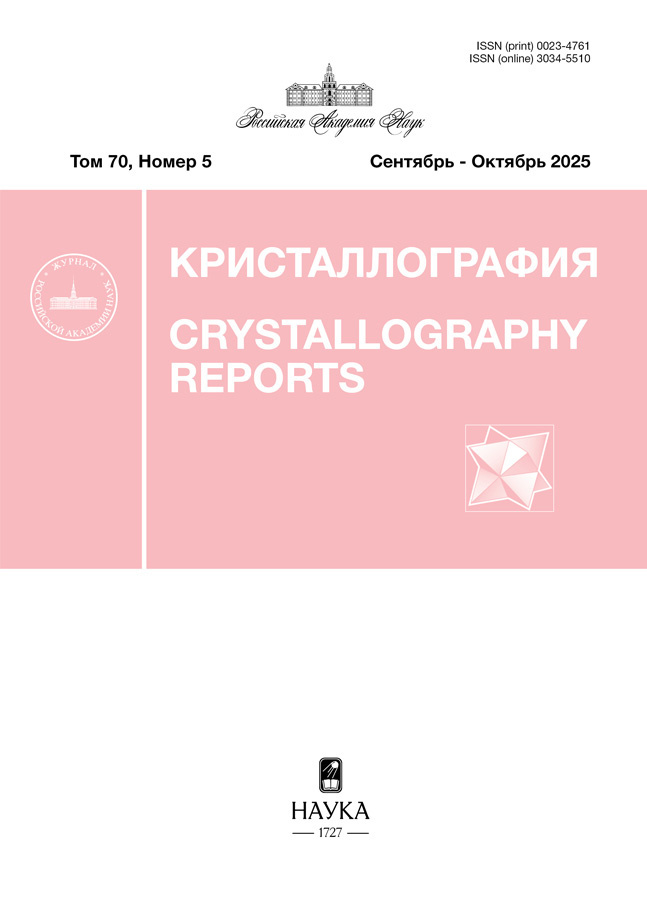Studying the X-ray absorption fine structure spectra of a protein monolayer on liquids. The possibilities of multi-pass technique.
- Authors: Novikova N.N.1, Trigub A.L.1, Rogachev A.V.1, Yalovega G.E.2, Lysenko V.Y.2, Pronina E.V.2, Kosmachevskaya O.V.3, Topunov A.F.3, Yakunin S.N.1
-
Affiliations:
- National Research Center “Kurchatov Institute”
- Southern Federal University
- Bach Institute of Biochemistry, Federal Research Centre “Fundamentals of Biotechnology”, Russian Academy of Sciences
- Issue: Vol 70, No 5 (2025)
- Pages: 800-809
- Section: ПОВЕРХНОСТЬ, ТОНКИЕ ПЛЕНКИ
- URL: https://vestnik-pp.samgtu.ru/0023-4761/article/view/693863
- DOI: https://doi.org/10.31857/S0023476125050103
- EDN: https://elibrary.ru/vfygfh
- ID: 693863
Cite item
Abstract
About the authors
N. N. Novikova
National Research Center “Kurchatov Institute”
Email: nn-novikova07@yandex.ru
123182, Moscow, Russia
A. L. Trigub
National Research Center “Kurchatov Institute”123182, Moscow, Russia
A. V. Rogachev
National Research Center “Kurchatov Institute”123182, Moscow, Russia
G. E. Yalovega
Southern Federal UniversityFaculty of Physics, 344090, Rostov-on-Don, Russia
V. Y. Lysenko
Southern Federal UniversityFaculty of Physics, 344090, Rostov-on-Don, Russia
E. V. Pronina
Southern Federal UniversityFaculty of Physics, 344090, Rostov-on-Don, Russia
O. V. Kosmachevskaya
Bach Institute of Biochemistry, Federal Research Centre “Fundamentals of Biotechnology”, Russian Academy of Sciences119071 Russia
A. F. Topunov
Bach Institute of Biochemistry, Federal Research Centre “Fundamentals of Biotechnology”, Russian Academy of Sciences119071 Russia
S. N. Yakunin
National Research Center “Kurchatov Institute”123182, Moscow, Russia
References
- Mara M.W., Hardt R.G.H., Reinhard M.E. et al. // Science. 2017. V. 356. P. 1276. https://doi.org/10.1126/science.aam6203
- Boffi F., Ascone I., Della Longa S. et al. // Eur. Biophys. J. 2003. V. 32. Р. 329. https://doi.org/10.1007/s00249-003-0283-1
- Wang C., Zhang R., Wei X. et al. // Adv. Immunol. 2020. V. 145. P. 187. https://doi.org/10.1016/bs.ai.2019.11.007
- Blindauer C.A., Harvey I., Bunyan K.E. et al. // J. Biol. Chem. 2009. V. 284. P. 23116. https://doi.org/10.1074/jbc.M109.003459
- Handing K.B., Shabalin I.G., Kassaar O. et al. // Chem. Sci. 2016. V. 7. P. 6635. https://doi.org/10.1039/c6sc02267g
- Al-Harthi S., Chandra K., Jaremko L. // Front. Chem. 2022. V. 10. P. 942585. https://doi.org/10.3389/fchem.2022.942585
- Ankudinov A., Ravel B. // Phys. Rev B. 1998. V. 58. P. 7565. https://doi.org/10.1103/PhysRevB.58.7565
- Hedin L., Lundqvist B. // J. Phys. C. 1971. V. 4. P. 2064. https://doi.org/10.1088/0022-3719/4/14/022
- Newville M. // J. Synchrotron Radiat. 2001. V. 8. P. 96. https://doi.org/10.1107/S0909049500016290
- Sugio S., Kashima A., Mochizuki S. et al. // Protein Eng. 1999. V. 12. P. 439. https://doi.org/10.1093/protein/12.6.439
- Рогачев А.В. Развитие поверхностно-чувствительных рентгеновских методов для нанодиагностики биоорганических слоев на жидкости: Дис. … канд. физ.-мат. наук. М.: НИЦ КИ, 2022. 198 с.
- Klockenkämper R., Von Bohlen A. Total-reflection X-ray fluorescence analysis and related methods. John Wiley and Sons, 2015. 552 p.
- Benjamini Y., Hochberg Y. // J. R. Stat. Soc. B. 1995. V. 57. P. 289. https://doi.org/10.1111/j.2517-6161.1995.tb02031.x
- Altman D.G., Bland J.M. // BMJ. 2005. V. 331. P. 903. https://doi.org/10.1136/bmj.331.7521.903
- Yalovega G.E., Kremennaya M.A. // Crystallography Reports. 2020. V. 65. P. 813. https://doi.org/10.1134/S1063774520060395
- Novikova N.N., Kovalchuk M.V., Yurieva E.A. et al. // J. Phys. Chem. B. 2019. V. 123. P. 8370. https://doi.org/10.1021/acs.jpcb.9b06571
- Smolentsev G., Feiters M.C., Soldatov A.V. // Nucl. Instrum. Methods Phys. Res. A. 2007. V. 575. P. 168. https://doi.org/10.1016/j.nima.2007.01.059
- Joly Y. // Phys. Rev. 2001. V. 63. P. 125120. https://doi.org/10.1103/physrevb.63.125120
- Лысенко В.Ю., Кременная М.А., Яловега Г.Э. // Кристаллография. 2023. Т. 68. С. 228. https://doi.org/10.31857/S002347612302011X
- Chen W.T., Liao Y.H., Yu H.M. et al. // J. Biol. Chem. 2011. V. 286. P. 9646. https://doi.org/ 10.1074/jbc.M110.177246
- Zahid M., Chen N., Liu D. et al. // Chem. Phys. Lett. 2024. V. 854. P. 141559. https://doi.org/10.1016/j.cplett.2024.141559
- Roy A., Tiwari S., Karmakar S. et al. // Int. J. Biol. Macromol. 2019. V. 123. P. 409. https://doi.org/10.1016/j.ijbiomac.2018.11.120
- Maciazek-Jurczyk M., Janas K., Pozycka J. et al. // Molecules. 2020. V. 25. P. 618. https://doi.org/ 10.3390/molecules25030618
- Хромова В.С., Мышкин А.Е. // Журн. общей химии. 2002. Т. 72. С. 1645.
Supplementary files











